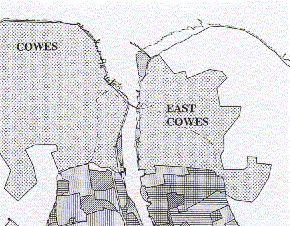2.5.0 Landscape
2.5.1 Background
The Medina Estuary is predominantly a rural estuary with the urban areas of Cowes and Newport at its northern and southern extremes. The rural landscape is characterised by a wide shallow valley comprising gently sloping pasture and arable farmland, pockets of woodland with saltmarsh and intertidal mudflats at the land/water interface. A dominant feature of the landscape is the visual change caused by the tidal cycle. Table 2 outlines the distinctive features which characterise the landscape of the estuary. The locations of the key features are illustrated in Map 3.
2.5.2 Issues
2.5.2.1 Development and visual quality
Development adjacent to the estuary has occurred primarily at the urban fringes of Cowes and Newport but includes sites in other areas, for example: the Saro Works and Stag Lane sites. While the functions of the estuary necessitate urban/industrial development, landscape improvements to these sites would greatly improve its visual appearance. In addition, any redevelopment or new development should respect the estuarine setting, aim to complement the landscape and have minimal impact upon it.
2.5.1 Background
The Medina Estuary is predominantly a rural estuary with the urban areas of Cowes and Newport at its northern and southern extremes. The rural landscape is characterised by a wide shallow valley comprising gently sloping pasture and arable farmland, pockets of woodland with saltmarsh and intertidal mudflats at the land/water interface. A dominant feature of the landscape is the visual change caused by the tidal cycle. Table 2 outlines the distinctive features which characterise the landscape of the estuary. The locations of the key features are illustrated in Map 3.
2.5.2 Issues
2.5.2.1 Development and visual quality
Development adjacent to the estuary has occurred primarily at the urban fringes of Cowes and Newport but includes sites in other areas, for example: the Saro Works and Stag Lane sites. While the functions of the estuary necessitate urban/industrial development, landscape improvements to these sites would greatly improve its visual appearance. In addition, any redevelopment or new development should respect the estuarine setting, aim to complement the landscape and have minimal impact upon it.
| Objective L1 To maintain and enhance the estuarine landscape. |
The open rural landscape of the estuary is an essential landscape feature of the estuary which is of important amenity and ecological value.
| Objective L2 To preserve and enhance the open rural landscape. |
Table 2 : Landscape features of the Medina Estuary
| Landscape Features | Characteristics |
| • agriculture |
|
| • intertidal mudflats |
|
| • grassland |
|
| • saltmarsh |
|
| • woodland and scrub |
|
| • historical and urban |
|
| • derelict and waste land |
|
Poor maintenance of the estuary results in negative impacts on the estuary landscape. Neglected or patched up defences, litter and poorly maintained structures all have a negative effect on visual quality.
| Objective L3 To promote a high standard of maintenance of the estuary landscape. |
2.5.2.2 Landscape Awareness
The environment and composite features of the estuary is used by, and is of interest to, a wide range of people including local communities, recreational users, industry, local authorities and local groups. There is a need to ensure that all parties are aware of the amenity value of the estuary and the options available for its conservation and enhancement.
| Objective L4 To promote enjoyment, awareness and understanding of the estuary landscape. |
Map 3: Landscape Features

Click here to see the whole map
Click here to see the Landscape Action Plan
Page last updated on: 04/09/2001





